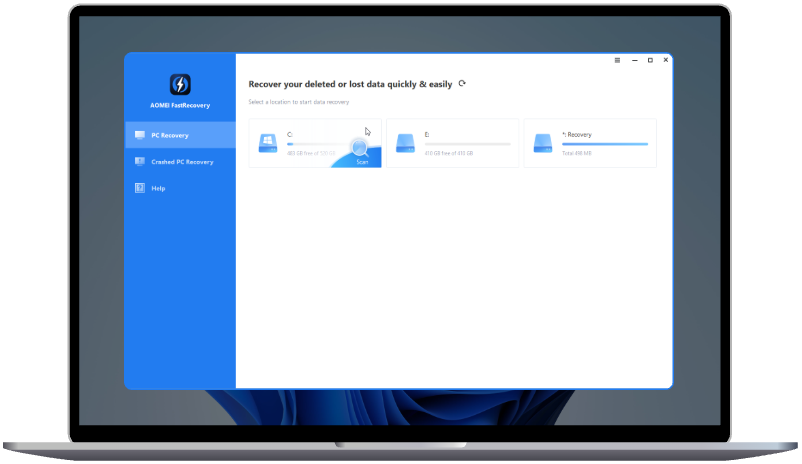How to Test USB Flash Speed in Windows 11/10
How to know whether your USB drive is slow or not? Just read this article to learn two easy ways to test USB flash speed right now! You can also learn how to make your USB run faster on this page.
Why is your USB speed slow?
USB flash drives are commonly used for transferring data between devices. Thanks to technological advances, they have become fast, reliable, and highly portable.
As USB flash drives continue to grow in popularity, they are now a ubiquitous part of daily life. However, simply owning a USB drive isn’t enough—you must choose one with speed in mind.
But are USB flash drives inherently slow, or do other factors contribute to slower performance? The answer is that several factors can affect USB speed. Let’s explore some common reasons:
⊷ USB port
Modern computers typically have USB 2.0 and USB 3.0 ports. Connecting a USB 3.0 flash drive to a USB 2.0 port will reduce its speed significantly. For optimal performance, ensure that you connect your USB devices to a USB 3.0 port, which is much faster.
⊷ USB controller drivers
Outdated or incompatible USB controller drivers can also slow down your transfer speed. Always check for updates to ensure your drivers are up to date and fully compatible with your USB drive.
⊷ Viruses and bad sectors
Viruses or corrupted sectors on your USB drive or system can severely impact data transfer speeds. It's essential to resolve any issues related to viruses or bad sectors to maintain optimal performance.
⊷ Incompatible file system
When formatting a USB drive, ensure it’s formatted using a compatible file system, with NTFS being the recommended choice. An incorrect file system format can slow down data transfer.
In summary, if you test USB flash speed frequently, you can better know whether you have the best performance, helping you make better purchasing decisions, and allowing you to monitor its health over time.
How to test USB flash speed in Windows 11/10
Here, I will present two step-by-step methods for testing hard drive speed: one using a built-in Windows tool, and the other with a professional USBspeed test software. You can select the method that best suits your needs.
Method 1. Use Task Manager to test USB speed
If you're seeking a freeway to test read write speed USB flash drive on Windows, you can use Task Manager. While this method is simple, it only provides basic information.
Step 1. Type "Task Manager" in the search bar and open the application.
Step 2.Once open, navigate to the "Performance" tab.
Step 3. From the list on the left, select the disk you want to test. You’ll then see basic data about that disk, including its read and write speeds.
Method 2. Test flash drive speed with USB speed test software
As you can see, the data provided by Task Manager is quite limited when it comes to assessing your hard drive’s speed. For a more detailed analysis, you’ll need to explore other options.
I highly recommend AOMEI Partition Assistant, an excellent hard drive speed testing tool with a user-friendly graphical interface. With just a few clicks, users can test the speed of hard drives, including external drives, HDDs, and SSDs. It offers a variety of test results, giving you a comprehensive view of your hard drive’s performance.
Additionally, AOMEI Partition Assistant offers two testing modes: Simple Mode and Pro Mode. Simple Mode tests the read and write speeds of the target drive and allows you to export the results. Pro Mode, on the other hand, provides a more in-depth analysis, including metrics such as maximum and average speeds, test size, number of tests, and duration.
Step 1. Install and run AOMEI Partition Assistant. Select the target disk, click the "Test" menu, and choose "Disk Speed Test".
Part 1. Simple Mode
Step 2. The Simple Mode is selected by default, you can click "Start" to begin testing.
Step 3. Wait for a while, you can see the result directly and you are able to export the result in different forms.
Part 2. Pro Mode
Step 4. Or you can click "Pro Mode" to test the hard drive comprehensively.
Step 5. In the new window, you can change the default settings as you wish: Partition, Average/Maximum speed, Size, Test Number, and Duration. After everything is set, click "Start" to begin testing the hard drive.
Step 6. When the test is done, you can see the result directly on the interface, and also you can export the result as you like.
Further tips: How to make USB flash drive run faster
If, after testing, you find that your USB flash drive is performing slower than expected, you might be wondering how to optimize its speed. Fortunately, AOMEI Partition Assistant is not only a powerful USB flash drive speed test software but also a practical USB optimization tool that offers many other features to help make a slow USB drive run faster.
┃ Delete unnecessary files
A slow USB flash drive is often the result of having too many files stored on it. To improve performance, consider moving files or folders to a different drive, or deleting unnecessary files, especially large ones that are rarely used. You can easily scan and remove these large files using AOMEI Partition Assistant.
Step 1. On the main interface of AOMEI Partition Assistant, click "Free up" and select "Delete Large Files".
Step 2. After selecting the partitions that you want to find and delete large files from, click "Start Scan".
Step 3. Then, it will list all large files when the scan is complete. Tick the files you want to delete, and then click "Delete" > "Delete Now" to confirm the deletion operation.
┃ Reformat USB drive (data loss)
If the previous methods don’t improve performance, the last option is to reformat your USB drive. Keep in mind that reformatting will erase all data, so ensure you’ve backed up any important files before proceeding. (If the USB even can’t finish the duplication, after formatting, you can try a data recovery tool to restore the formatted USB). AOMEI Partition Assistant can also bypass file system size limitations, allowing you to format drives larger than 32GB into FAT32.
Step 1. Install and launch AOMEI Partition Assistant. Right-click the USB drive and select “Format Partition”.
Step 2. Choose the NTFS under the “File System” drop-down menu, and click on “OK”.
Step 3. Click on “Apply” and “Proceed” to commit the pending operation.
Conclusion
A USB flash drive with good read and write speeds can significantly boost your work efficiency. This guide covers three effective methods to testUSBflash speed, as well as provides several strategies for speeding up a slow drive.
To take preventive measures and protect your hard drive, AOMEI Partition Assistant can help you monitor disk health, back up important data through disk cloning, and more. Additionally, it can assist in resolving unexpected issues, such as repairing USB RAW file system, solving USB flash drive not recognized, fixing USB detected but not accessible, etc.

